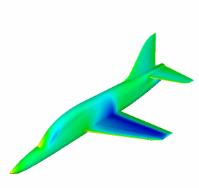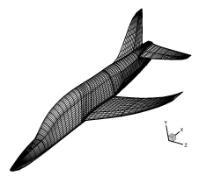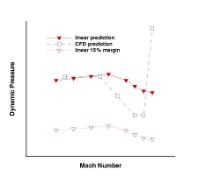Time Domain
The overall aim of our research is to make CFD level aerodynamics usable for the prediction of aeroelastic responses of aircraft. The baseline approach is to calculate this response in the time domain. We bring our well validated multiblock code to this task. The important features of the code are:
- Time Accurate
- Moving Grids
For the structure we use a modal description. The two sets of equations are coupled in pseudo-time to avoid sequencing errors. An important consideration is the transfer of information between the fluid and the structural grids. Demonstration of the method has been made for the BAE Systems Hawk trainer.
|
|
|
|
|
Hawk Trainer Aircraft Pressure |
Hawk Trainer Aircraft Mode |
Hawk Trainer Aircraft Flutter |
|
4aero_hawk_cp.jpg (44kB) |
4aero_hawk_modes.jpg (115kB) | 4aero_hawk_boundary.jpg (57kB) |
Publications
-
Woodgate, M.A., Badcock, K.J., Rampurawala, A.M. and Richards, B.E., Aeroelastic Calculations for the Hawk Aircraft Using the Euler Equations, Journal of Aircraft, Vol 42, No 4, pp 1005-1012, 2005.
-
Goura, G.S.L, Badcock, K.J., Woodgate, M.A. , Richards, B.E., A data exchange method for fluid-structure interaction problems, Aeronautical Journal, April, 2001, 215-221.
-
Goura, G.S.L., Badcock, K.J., Woodgate, M.A., Richards, B.E., Implicit method for the time marching analysis of flutter, Aeronautical Journal, April, 2001, 199-214.
-
Goura, G.S.L. Time Marching Analysis of Flutter Using Computational Fluid Dynamics. University of Glasgow, PhD Thesis 2001.
-
Rampurawala, A.M. and Badcock, K.J., Treatment of Complex Configurations for Flutter Calculations, AIAA-2006-2077, Structural Dynamics and Materials Conference, Newport, Rhode Island, 1-4 May, 2006.
-
Rampurawala, A.M. Aeroelastic analysis of aircraft with control surfaces using CFD. PhD Thesis, 2006
Contact: Ken Badcock


